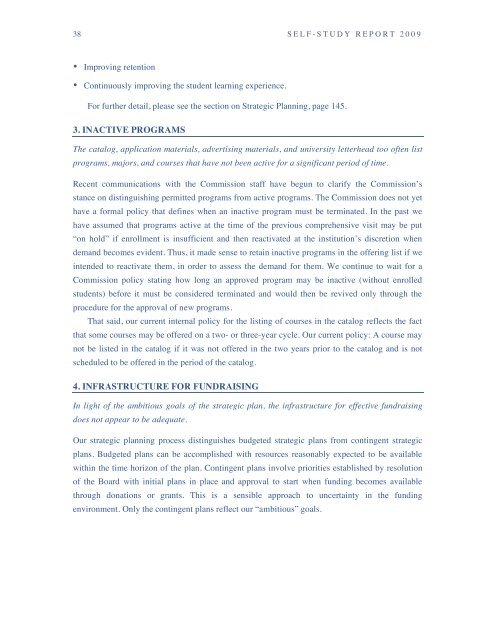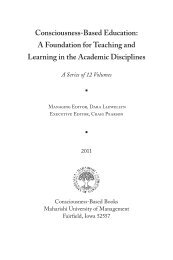Self Study - Maharishi University of Management
Self Study - Maharishi University of Management
Self Study - Maharishi University of Management
You also want an ePaper? Increase the reach of your titles
YUMPU automatically turns print PDFs into web optimized ePapers that Google loves.
38 S E L F - S T U D Y R E P O R T 2 0 0 9<br />
• Improving retention<br />
• Continuously improving the student learning experience.<br />
For further detail, please see the section on Strategic Planning, page 145.<br />
3. INACTIVE PROGRAMS<br />
The catalog, application materials, advertising materials, and university letterhead too <strong>of</strong>ten list<br />
programs, majors, and courses that have not been active for a significant period <strong>of</strong> time.<br />
Recent communications with the Commission staff have begun to clarify the Commission’s<br />
stance on distinguishing permitted programs from active programs. The Commission does not yet<br />
have a formal policy that defines when an inactive program must be terminated. In the past we<br />
have assumed that programs active at the time <strong>of</strong> the previous comprehensive visit may be put<br />
“on hold” if enrollment is insufficient and then reactivated at the institution’s discretion when<br />
demand becomes evident. Thus, it made sense to retain inactive programs in the <strong>of</strong>fering list if we<br />
intended to reactivate them, in order to assess the demand for them. We continue to wait for a<br />
Commission policy stating how long an approved program may be inactive (without enrolled<br />
students) before it must be considered terminated and would then be revived only through the<br />
procedure for the approval <strong>of</strong> new programs.<br />
That said, our current internal policy for the listing <strong>of</strong> courses in the catalog reflects the fact<br />
that some courses may be <strong>of</strong>fered on a two- or three-year cycle. Our current policy: A course may<br />
not be listed in the catalog if it was not <strong>of</strong>fered in the two years prior to the catalog and is not<br />
scheduled to be <strong>of</strong>fered in the period <strong>of</strong> the catalog.<br />
4. INFRASTRUCTURE FOR FUNDRAISING<br />
In light <strong>of</strong> the ambitious goals <strong>of</strong> the strategic plan, the infrastructure for effective fundraising<br />
does not appear to be adequate.<br />
Our strategic planning process distinguishes budgeted strategic plans from contingent strategic<br />
plans. Budgeted plans can be accomplished with resources reasonably expected to be available<br />
within the time horizon <strong>of</strong> the plan. Contingent plans involve priorities established by resolution<br />
<strong>of</strong> the Board with initial plans in place and approval to start when funding becomes available<br />
through donations or grants. This is a sensible approach to uncertainty in the funding<br />
environment. Only the contingent plans reflect our “ambitious” goals.

















